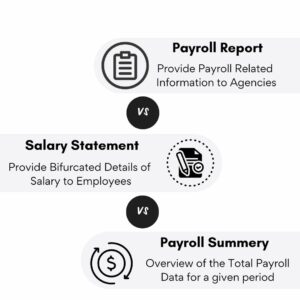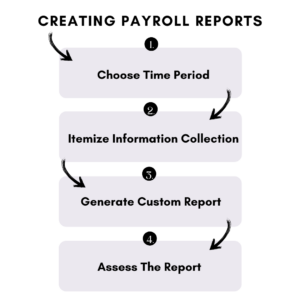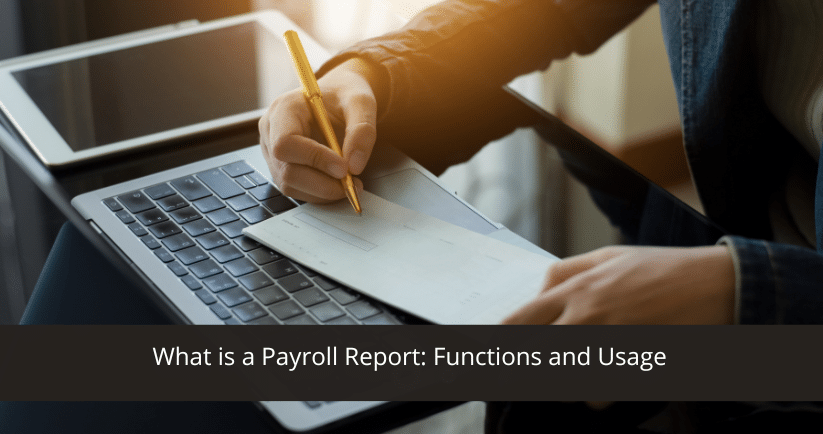Payroll Reports are essential for any organization since it serves in improving the overall organizational efficiency as well as helping maintain compliance. Payroll reports provide the organization and the HR team with vital information regarding their employees and their payroll, which helps them make informed decisions.
Payroll reports are also an essential component of company audits as it provides the financial details of the organization with respect to the employees in the company. These reports provide the relevant information for Income Tax audits, making them an essential part of compliance handling.
Hence, let us learn about its functions and usage.
What is a Payroll Report?
Payroll Reports are documents generated to provide financial details of the company for a specific pay cycle. It includes various information related to the finances of the company, such as the pay rate, total number of work hours, the TDS deducted from employee salary, and more.
There are various kinds of payroll reports generated by the accounts and HR departments for different purposes. While some of them are generated for filing with the state agencies, others are developed for internal usage of the company. Nowadays, payroll reports are generated with the help of dedicated payroll and HRMS software, which ensures accuracy while providing updated information.
Payroll Report vs. Pay Statement vs. Payroll Summary
There is a common confusion between a payroll report, a pay statement, and a payroll summary, as they are quite similar in usage. However, all three of them serve different purposes.
Let us look at what each of them is used for and understand how they are used differently:

Payroll Report
As explained above, a ‘payroll report’ is used to provide specific payroll-related information to the state and law agencies, such as the Income Tax department. These reports are also used to store accurate payroll information for internal usage by the company too.
Also Read: What is Payroll Outsourcing?
Pay Statement
The ‘pay statement’ is a report which provides crucial information related to an employee’s salary, which provides the bifurcation of their salary structure into its components such as net pay, taxes, other deductions, etc. It is generated for sharing with the employees, as it helps them understand their earnings better.
Payroll Summary
A ‘payroll summary’ is an overview of the total payroll data for a given period. Being a summary, it consists of a bird’s eye view of the payroll data and lacks in-depth details. One must note that it consists of all information related to the payroll of the employees, such as overall wages paid, taxes deducted, etc. without getting into the details of the same.
Advantages of Payroll Report
Generating a payroll report has multiple benefits for both the employer and the employees of an organization. Some of the most common advantages of a payroll report are:
Efficient Tax Calculations
Calculating employee payroll and the associated taxes takes a lot of productive time for the HR department. However, if they can generate payroll reports with the help of dedicated HRMS or payroll software, the process becomes easier and streamlined for the team. It results in accurate taxes calculations and on-time payments, resulting in fine avoidance.
Easier Budgeting
With the help of payroll reports, the HR and accounts team can easily determine the cost of paying employees, which helps in better budgeting for the future. It also helps in accurately predicting the expenses for the next salary cycle or even the next quarter, making it a must-have tool in the HR arsenal.
Track Different Metrics
Payroll reports also provide HR with actionable insights over various aspects of payroll such as salary components, paid time offs taken, expenditure on additional benefits, rewards, and more. Tracking these metrics will help the HR team in making necessary changes for better employee engagement and retention.
Types of Payroll Reports
There are numerous kinds of payroll reports generated for gathering insights as well as for staying compliant with the regulations. Some of the most common payroll reports are:
Employee Summary
Employee summaries are usually generated to provide the personal information of the employees along with their pay and tax details. It includes the staff member’s personal data such as their full name, contact details, hiring date, academic details, etc. along with their salary information such as hourly rate, tax details, etc.
Payroll Preview
Payroll preview reports provide in-depth line-by-line details of the salary information of the staff members. It also includes tax-related details as well as information regarding the deductions due to it. These reports enable the HR team to view the payroll details to find inconsistencies in the data.
Compensation Report
The compensation report deals with employee insurance and hence, it provides insurance data such as premium details, insured amount, etc. Depending on the insurance service provider and the local laws, the compensation report is highly modifiable. It is also referred to as a ‘ workers’ compensation’ report.
Payroll Service Charges
The payroll service charges report provides the status of invoices from a payroll service provider. It helps understand the bifurcation of the different charges of employee payroll system. It also helps understand the ROI of the system and make any changes to maximise it. The payroll service charges report also provides information about the payment details to the service provider.
PTO Report
The PTO report or the Paid Time Off report provides HR with the leave details of the employees in an organization. It provides in-depth information about leaves taken by the personnel, helping in better staffing and shift schedules for the future. The PTO report helps avoid labour shortages too.
Error Report
The error report contains the numerous errors that happened in the previous salary cycle, which helps HR avoid the same mistakes with the current one. It helps them analyse what went wrong as well as provides an easy database of employees who have received lesser salaries. It helps improve payroll accuracy over time.
Liability Report
The liability report provides information regarding funds required for paying employees and processing payroll. It includes the amount payable to the employees and the associated taxes; however, it does not contain the payroll provider’s fees. The liability report provides the accounts and HR teams with better budgeting options.
Tax Liability
Tax liability reports provide the HR team with the tax details of employee payroll. It helps them understand the numerous taxes that the company is liable to pay the authorities for employing staff and undertaking business. It also helps them understand their liabilities towards the authorities and how much are they required to pay the next salary cycle.
Pension Contribution
The Pension or Retirement Contribution Reports are a staple of internal HR reporting as they provide the management with in-depth details about the pension requirements of the employees. It helps them allocate the required budgets and provides them with a robust idea of the employees and their tenure with the company.
Creating Payroll Reports
Now that we have understood the basics of payroll reports, we shall look at the steps involved in the generation of the reports. While the exact process of report generation and data collation would change depending on the type of payroll report, the size of the company and the number of employees working on the report, it usually follows a specific path in general.
Following are some of the common steps required in developing a payroll report:

Choose Time Period
Any kind of payroll report is generated for a specific period. Hence, choosing the dates for the report is the first step in generating it. Additionally, one should also keep in mind the numerous kinds of payroll reports required, such as the ones that are required by the law and the ones used for internal reporting.
Itemize Information Collection
In this step, one needs to decide the components of the report. Various information is collated as a part of the report generation process, such as employee name, working hours, salary pay-out and its bifurcation, taxes deducted, etc. The selection of data items would be decided based on the report and its function.
Generate Custom Report
Based on the time and the data components, the report can be generated manually on spreadsheets. However, a more refined approach would be to take the help of an HRMS or payroll software to generate custom reports based on the chosen parameters. It would also ensure the accuracy of the data.
Assess the Report
Once the report is generated, one needs to analyse the data to gather insights about the information and the company. The management can gather various valuable insights with the help of the report such as the amount required for employee salaries, the appraisal budget, employee leaves, and more. With this information, they can make informed decisions, ensuring the company’s success.
Conclusion
Payroll reports store multiple crucial data such as employee payroll information, pay rate, TDS, overtime charged and their rates, additional benefits provided and their cost to the company, employee leaves and related information, and more. Hence, these reports help in improving the overall efficiency of the payroll management of the organization.
Payroll reports are extremely crucial for the success of an organization as it helps in taking informed decisions, while also providing the HR and management with valuable data. Hence, one should take precautions to ensure the complete accuracy of the data and utilize the latest innovations such as HR software for the same.








